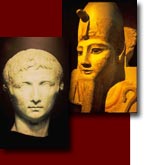| Site Map | Contacts | Links | Newsletter | |
History:
Egyptian
Egypt was divided into Upper and Lower Egypt, or the two lands. Narmer was the first to unite Upper and Lower Egypt which is the beginning of the first Egyptian Dynasty 0. He was the first king of the two lands wearing the White Crown of Upper Egypt (looks like a bowling pin), and the Red Crown of Lower Egypt. The Egyptian Dynasty ends with the suicide of Cleopatra, and the Roman army under Octavian taking Egypt in 30 BC. Below is an overview, and then a detailed outline with key points especially as related to Israel.
I. Early Dynastic Period - 3150-2686 BC. (Dynasties 0-2)
II. The Old Kingdom - 2686-2181 BC. (Dynasties 3-6)
1. First Intermediate Period - 2181-2040 BC. Dynasties 7-10.
III. The Middle Kingdom - 2040-1782 BC. Dynasties 11-12.
2. Second Intermediate Period - 1782-1570 BC.
IV. The New Kingdom - 1570-1070 BC. Dynasties 18-19.
3. Third Intermediate Period - 1069-525 BC.
V. The Late Period - 525-332 BC. Persian Conquest
VI. The Graeco-Roman Period - 332-641 BC.
Recommended Books and Websites
For an over all view of Egyptian history with pictures read "Chronicle of the Pharaohs" by Peter A. Clayton. I recommend reading some primary source texts in ANET = Ancient Near Eastern Texts edited by James B. Pritchard, 1969. There is a cheaper paperback edition that includes pictures, "The Ancient Near East" Volume 1 edited by Pritchard (ANE 1). There is also volume 2 (ANE 2), but most texts will be in volume 1. I will use ANE 1 for the paperback edition page numbers, and fig. for picture number in the back of the book. A few texts are not in the paperback edition. Herodotus "The Histories" is a good book for stories from the Late period. There are cheap paperback editions (Penguin Classics) at most major book stores. Another good book is "The Life and Works of Josephus" translated by William Whiston.
- For an excellent web site see the Ancient History Sourcebook
- Egyptian Virtual Museum
- Monuments and Sights to See In Egypt
- History of Egypt
I. Early Dynastic Period - 3150-2686 BC. (Dynasties 0-2)
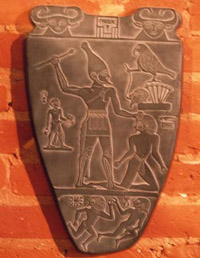 |
Palette of Narmer |
-
Dynasty 0 - 3150-3050 BC. Narmer the scorpion, unites Egypt. ANE 1, fig.84. see The Palette of Narmer .
-
Dynasty 1 - 3050-2890 BC.
- Hor-Aha. Probably Narmer's son by Queen Nithotep. Hor-aha's greatest achievemnet was the founding of the capital city of Memphis. Memphis survived throughout Egyptian history, and was one of the greatest cities in the ancient world. Herodotus claims that Menes (Hor-Aha) dammed the Nile just south of the city so he could build Memphis (Book 2:99). Manetho states that he reigned for 62 years. Egyptian kings begin to construct their tombs in Abydos, and the nobles build their tombs in the desert plateau of Saqqara. Hor-Aha's tomb is B 19 at Abydos.
- Djer. He reigned 57 years. Tomb O at Abydos.
- Djet (Uadji). Tomb Y at Abydos.
- Den (Udimu). He reigned 20 years. Tomb Z at Abydos.
- Anedjib. He reigned 26 years. Tomb X at Abydos.
- Semerkhet. He reigned 9 years. Tomb U at Abydos.
- Qa'a. He reigned 26 years. Tomb Q at Abydos.
-
Dynasty 2 - 2890-2686 BC.
- Hotepsekhemwy. He reigned 38 years.
- Raneb. He reigned 39 years.
- Nynetjer. He reigned 47 years.
- Seth-Peribsen. He reigned for 17 years.
- Khasekhemwy. He reigned for 30 years. He has a huge tomb at Abydos where they found his golden sceptre, and several small stone pots with gold leaf lids (on display in the British Museum).
II. The Old Kingdom - 2686-2181 BC. (Dynasties
3-6)
The Pyramid Builders

For an excellent site on the pyramids see Pyramids, the Inside Story.
-
Dynasty 3 - 2686-2613 BC.
-
Sanakhte - 2686-2668 BC.
-
Djoser - 2686-2649 BC.
-
The Step Pyramid ANE 1,fig.191. See this at The Step Pyramid Complex of Djoser.
-
Vizier Imhotep
-
Tradition of Seven Lean Years, ANET, 31; ANE 1, 24. Text was written in the Ptolemaic period.
-
-
Dynasty 4 - 2613-2498 BC.
-
Snefru - 2613-2589 BC.
- Meydum Pyramid
- A. The Bent Pyramid
- The Red Pyramid
- Khufu - 2589-2566 BC.
-
The Great Pyramid - Did aliens build the pyramids? Is the gospel and future prophecies of the end in the Great Pyramid? See Gospel in the Pyramids.
- Hemon the master builder: See The Various Possible Methods of Pyramid Construction.
- The royal ships buried at the base of the Pyramid to journey to the netherworld.
-
Djedefre - 2566-2558 BC.
-
Khafre - 2558-2532 BC.
-
The Great Sphinx ANE 1, fig.192. See The Great Sphinx.
-
The Second Pyramid of Giza
-
- Menkaure - 2532-2504 BC.
-
The Third Pyramid of Giza
-
- Shepseskaf
-
-
-
Dynasty 5 - 2498-2345 BC.
-
Unas - 2375-2345 BC. His Pyramid see Pyramid of Unas at Saqqara.
-
First Pyramid Texts - 228 spells which are later complied into the "Book of the Dead" by the 18th Dynasty. See The Egyptian Book of the Dead.
-
-
-
Dynasty 6 - 2345-2181 BC.
Story of Weni - How Weni rose to power to become General of the army. It is the first record of Egypt's attack on southern Palestine. "Ancient Egyptian Literature" Volume I by Miriam Lichtheim, 1975, paperback, page 18.
1. First Intermediate Period - 2181-2040 BC. (Dynasties 7-10)
Asiatics from the east invade the Delta.
The "Admonitions of Ipuwer" was possibly written at this time or later in the Middle Kingdom. It describes this period as "the land spins around as a potter's wheel...the River (Nile) is blood" ANET, 441.
III. The Middle Kingdom - 2040-1782 BC. (Dynasties 11-12)
Egypt is reunited. Coffin Texts (Writing on the coffins) are found. During the 12th Dynasty two great texts were penned: The Instructions of Amenemhet (Similar to Proverbs) ANET, 418, and The Story of Sinuhe. Sinuhe over hears a plot to kill the king. He flees fearing he will be implicated as well. The Palestinian Prince of Retjenu takes him in. It gives us a glimpse into life in ancient Palestine. When Sinuhe is old he is allowed to return to Egypt with honor. ANET, 18; ANE 1, 5.
Execration Texts: ANET, 328; ANE 1, 225; fig.153.
 There
are two types of execration texts from the 12th Dynasty of Egypt. The oldest
type are inscribed red clay bowls that date to the reign of Sesostris III
(1878-1842 B.C.). The second type, dating a generation or two later (Middle
Bronze II, 1800-1630 BC) are clay figurines which list cities along major
routes of travel (McCarter 1996, 43). The Egyptians practiced the magical
cursing of their enemies by inscribing pottery bowls and figurines with
the names of their enemies, and then smashing them to break the power of
their enemies. "Iy-anaq" is named which may be related to the
Anaqim or giants who dwelt in Canaan before the conquest (ANET 1969, 328).
There is the ruler of "Shutu" named Job. Shutu is probably Moab
the sons of Sheth (Numbers 24:17; Ahituv 1984, 184). There are the rulers
of Shechem, Hazor, Ashkelon, Laish, Tyre, and Pella ('Apiru-Anu). The ruler
of Shamkhuna is Abu-reheni (Abraham). The tribes of 'Arqata and Byblos are
mentioned (ANET 1969,329). Jerusalem is named, but there is no mention of
Israel. There is the interesting mention of the personal name "Zabulanu"
which is similar to the cuneiform for "Zebulon"(ANET 1969, 329
note 6). This was probably not the son of Jacob, but just a popular name?
In Ugaritic zbl is a place name (Gordon 1965, Text 1084:13; Glossary #815).
Rohl finds the name Jacob and Joseph (Iysipi, E31), but this is highly questionable
(1995, 352; ANET 1969, 329). The Execration texts seems to parallel the
time of the patriarchs. ANE 1,fig.153.
There
are two types of execration texts from the 12th Dynasty of Egypt. The oldest
type are inscribed red clay bowls that date to the reign of Sesostris III
(1878-1842 B.C.). The second type, dating a generation or two later (Middle
Bronze II, 1800-1630 BC) are clay figurines which list cities along major
routes of travel (McCarter 1996, 43). The Egyptians practiced the magical
cursing of their enemies by inscribing pottery bowls and figurines with
the names of their enemies, and then smashing them to break the power of
their enemies. "Iy-anaq" is named which may be related to the
Anaqim or giants who dwelt in Canaan before the conquest (ANET 1969, 328).
There is the ruler of "Shutu" named Job. Shutu is probably Moab
the sons of Sheth (Numbers 24:17; Ahituv 1984, 184). There are the rulers
of Shechem, Hazor, Ashkelon, Laish, Tyre, and Pella ('Apiru-Anu). The ruler
of Shamkhuna is Abu-reheni (Abraham). The tribes of 'Arqata and Byblos are
mentioned (ANET 1969,329). Jerusalem is named, but there is no mention of
Israel. There is the interesting mention of the personal name "Zabulanu"
which is similar to the cuneiform for "Zebulon"(ANET 1969, 329
note 6). This was probably not the son of Jacob, but just a popular name?
In Ugaritic zbl is a place name (Gordon 1965, Text 1084:13; Glossary #815).
Rohl finds the name Jacob and Joseph (Iysipi, E31), but this is highly questionable
(1995, 352; ANET 1969, 329). The Execration texts seems to parallel the
time of the patriarchs. ANE 1,fig.153.
Beni-Hasan tomb with pictures of Asiatic traders. ANE 1, fig.2. about 1890 BC.
2. Second Intermediate Period - 1782-1570 BC. (Dynasties 13-17)
-
Dynasty 13 - 1782-1650 BC.
-
Dynasty 14 - Contemporaneous with the 13th Dynasty
-
Dynasty 15 - 1663-1555 BC. (5 Kings) Hyksos Rule.
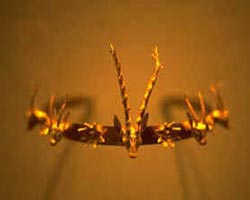
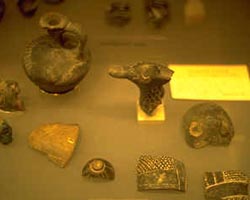
Hyksos princess crown Tell el-Yahudiyeh ware
Hyksos sacked Memphis about 1720 BC. Josephus quotes Manetho in "Against the Jews" (Book I) about this period. Manetho identifies Israel with the Hyksos which where expelled by Ahmose from Egypt. Josephus quotes Manetho describing this expulsion by saying: "Then the kings of the Thebaid and of the rest of Egypt rose in revolt against the shepherds (Hyksos), and a great war broke out, which was of long duration. Under a king named Misphragmouthosis, the shepherds, he says, were defeated, driven out of all the rest of Egypt, and confined in a place called Auaris, containing ten thousand arourae. The shepherds, according to Manetho, enclosed the whole area with a great strong wall, in order to secure all their possessions and spoils. Thoummosis, the son of Misphragmouthosis (he continues), invested the walls with an army of 480,000 men, and endeavored to reduce them to submission by siege. Despairing of achieving his object, he concluded a treaty, under which they were all to evacuate Egypt and go whither they would unmolested. Upon these terms no fewer than two hundred and forty thousand, entire households with their possessions, left Egypt, and traversed the desert to Syria. Then, terrified by the might of the Assyrians, who at that time were the masters of Asia, they built a city in the country now called Judaea, capable of accommodating their vast company, and gave it the name of Jerusalem" (1926,197-99; Against Apion, Book 1.85-90; Manetho 1940, 86, n.2; Whiston, 875).
-
Sheshi
-
Yakubher=Jacob-El?

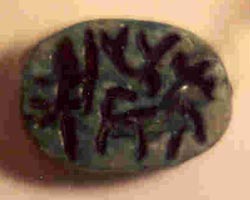
Hr meaning "mountain" or "rock" is identical to the word El or "god". In the Old Testament Zobel proposes: "The name (Jacob) is a hyocoristic form of what was originally a theophorous name belonging to the class of statement-names made up of a divine name and the imperfect of a verb. Its full form, not found in the OT, was 'Jacob-El'(1990, 188-9; Shanks 1988, 24-25). Therefore the name "Jacob" found in the Bible would be the same as the name "Jacob-El" which is found on a number of Hyksos Scarabs. Although this name was common among the Arameans, but uncommon among the Canaanites and Phoenicians (Zobel 1990, 189), R. Weil was the first to connect the Hyksos princes with the Biblical story of Jacob (Kempinski 1985, 134). In 1969 a scarab of Jacob-El was found in the Middle Bronze II tomb at Shiqmona, a suburb of Haifa, that was from a mid-18th century deposit 100-80 years before the Hyksos (Kempinski 1985, 132-3). The Jacob-El of Shiqmona must have been a local Palestinian ruler, possibly the same Jacob of the Bible. According to Genesis 32:23-33 Jacob's name was changed to Israel. Steuernagel was the first to propose the idea of the "Jacob tribe" or "proto-Israelite Jacob group" (Zobel 1990,194). It may be that the name "Israel" was not officially used until after the conquest of Canaan when a league of 12 tribes was formed. This would help explain the absence of the name "Israel" from early sources.
-
Khyan
-
Apepi I
-
Apepi II
-
Invasion and Rule by the Hyksos
-
Rise of Biblical Joseph to Power?
-
-
-
Dynasty 16 - 1633-1555 BC. (2 Kings)
-
Anather
-
Yakobaam - Name Similar to Biblical Jacob?
-
- Dynasty 17 - 1663-1570 BC. (5 Kings)
- This Dynasty was contemporary with the 15&16th Dynasties.
IV. The New Kingdom - 1570-1070 BC. (Dynasties 18-19)
Expulsion of the Hyksos = Pro-Israelites exodus from Egypt? The Autobiography of Ahmose, Son of Ebana tells this story. ANET, 233; ANE 1, 173, fig. 42.
-
Dynasty 18 - 1570-1293 BC.
-
Ahmose I - 1570-1546 BC Expelled the Hyksos ANEP, 310.
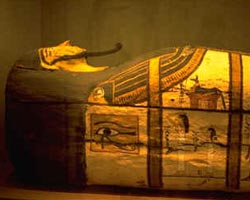
-
Amenhotep I - 1551-1524 BC.
-
Tuthmosis I - 1524-1518 BC.
-
Tuthmosis II - 1518-1504 BC.
-
Queen Hatshepsut - 1498-1483 BC. Famed trip to Punt.

- Tuthmosis III - 1504-1450 BC. His Asiatic Campaign ANET, 234; ANE 1, 175, fig.106,99,93,4. There is an interesting story about how Joppa was captured by soldiers who hid in 200 baskets that were brought into the city on a ruse (ANET 1969, 22). This probably happened on Thutmose III's first campaign.
(looking out from Tuthmosis III's tomb)
- Topographical List - 1481 BC. ANET, 242-3. ANEP, 313.
ANE 1, fig.88.
-
Jacob-El listed
-
Joseph-El listed
-
Amenhotep II - 1453-1419 BC.
-
Topographical List - 1440 BC.
-
Shasu - Possibily Proto-Israelites? Shasu is a general term used by Egyptians to describe Bedouins east of the Delta. When Israel was wandering in the desert they may have been identified with the Shasu, but when they moved into the hill country of Palestine, they were probably called Hapiru.
-
Hapiru - probably the Hebrews. The word Hebrew probably came from Hapiru.
-
-
-
Tuthmosis IV - 1419-1386 BC.
-
Amenhotep III - 1386-1349 BC.
-
Topographical List - 1386 BC. In the temple of Amon in Soleb (Nubia) there is a topographical list from the time of Amenhotep III (1408-1372 BC). In column IV.A2 is written t3 ssw yhw3 which means"Yahweh of the land of the Shasu" (Giveon 1964, 244; Redford 1992, 272; Astour 1979, 17-34). In the ancient Near East a divine name was also was given to a geographical place where the god was worshipped (Axelsson 1987, 60). This is the first clear extra-biblical evidence of the name "Yahweh."
-
Shasu
-
Asher - Tribe of Israel?
-
Joseph-El
-
Yaweh - First extrabiblical reference to Yahweh which says, "Yahweh of the land of the Shasu" (Giveon 1964, 244)
-
-
-
Akhenaten (Amenhotep IV) 1350-1334 BC. ANE 1, fig.108, 110.
-
Armana Letters- mentions Hapiru taking over. Letters from Jerusalem, and other Canaanite cities. See ANET, 483-490; ANE 1, 262, fig.107.
In 1887 an Egyptian peasant woman discovered a collection of cuneiform tablets at the site of Akh-en-Aton's capital from the 14th century BC There were a total of 377 tablets found. Later some more tablets were found. About half of them were written in Akkadian by Canaanite scribes in Palestine describing the conditions there. One major problem was the "Hapiru" who were taking over the land. They wanted the king of Egypt to send reinforcements."Hapiru" is probably related to the word "Hebrew" (Greenberg 1955, 91-2). Hapiru (Akkadian) is sometimes spelled "Habiru" or "'apiru" (Egyptian). The Egyptian word is 'pr. In these letters "Hapiru" is spelled with the Sumerian logogram SA.GAZ. Hapiru was a general term for "robber" or "migrant" (Astour 1962, 382).
The use of the term "Hebrew" in the Old Testament is found primarily in the pre-monarchical period, and used in unfavorable contexts by foreigners like the Egyptians (Gen 39:14,17, 41:12; Ex. 1:16, 2:6) and the Philistines (ISam 4:6,9; 13:3,19; 14:11; 29:3). The bands of David and Jephthah give some of the clearest pictures of what the Habiru were like (Mazar 1963, 310-20). It seems that later in history the social meaning of Hapiru was changed to an ethnic term for Israel. The social term Hapiru disappeared in ancient texts (12th century BC) mainly due to the rise of national states, but was kept in Israel and developed into an ethnic term (Na'aman 1986, 286).
The El Amarna (EA) 299 from Gezer says, "Now the Hapiru are prevailing over us. So may the King, my Lord, take me away from the land of the Hapiru, so that the Hapiru will not destroy us" (Na'aman 1979, 679; Moran 1992, 340). EA 273 says, "May the king, my lord, be informed that war is waged in the land and that the land of the king, my lord, is being ruined by going over to the Hapiru" (Na`aman 1979, 680; Moran 1992, 318). - Queen Nefertiti - ANE 1, fig.109.
-
Worship of the Sun, Aten (monotheism?) Hymn to the Aten, ANET, 369; ANE 1, 226, fig.108,110. Note the similarities to Psalm 104.
-
-
Tutankhamun (King Tut) 1334-1325 BC. Great discovery of his treasures by Howard Carter in 1922. ANE 1, fig.111.
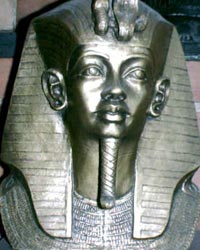
-
AY - 1325-1321 BC.
-
Horemheb - 1321-1293 BC.
-
-
-
Dynasty 19 - 1293-1185 BC.
"Tale of Two Brothers" tells a story similar to Joseph and Potiphar's wife. A young man is falsely accused of proposing adultery with his elder brother's wife. ANET, 23; ANE 1, 12, fig.10,16.-
Ramses I - 1293-1291 BC.
-
Seti I - 1291-1278 BC. His Campaign into northern Palestine, ANE 1, 182.
Topographical List mentions Shasu, Hapiru, and Asher. Pictures of the Shasu at Karnak in ANEP, 323-331. Compare this with the Israelites pictured on the "Black Obelisk" of Shalmaneser III ANEP, 351-355; ANE 1, fig. 100. -
Ramses II - 1279-1212 BC ANE 1, fig.112,99.
Topographical List mentions Shasu, Jacob-el, Asher, and Yahweh which says, "Yahweh of the land of the Shasu" Astour, 1979. He also battled the Hittites at Kadesh, ANET, 337. He almost lost his life. He signed a peace treaty with the Hiitites, ANET, 199. Marries Hittite princess, ANEP, 339. "A Satirical Letter" was written describing the geography of Canaan at this time. It mentions "Qazardi, chief of Asher" ANET, 477. -
Merneptah - 1212-1202 BC ANE 1, fig.113.
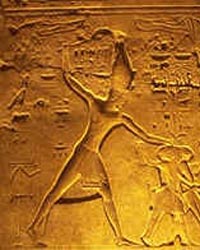
"The Merneptah Stela" first extrabiblical mention of "Israel" ANEP, 342-3; ANE 1, 231, fig.96. This is key is showing that Israel was all ready in Canaan by 1210 BC. Possible mention of him in Joshua 15:9 and 18:15 as the name of a fountain near Jerusalem, also ANET, 258. First invasion of the Sea People in Merneptah's fifth year. Possible earliest pictures of Israel at Karnark. -
Amenmesses - 1202-1199 BC.
-
Seti II - 1199-1193 BC. ANE 1, fig.114.
-
Siptah - 1193-1187 BC.
-
Queen Twosret - 1187-1185 BC.
-
Setnakhte - 1185-1182 BC.
-
Ramses III - 1182-1151 BC.
- War with the Sea People: Confederation
of 5 groups: the Peleset or Philistines, Dardany (probably the
Danaoi of Homer's Iliad; Tribe of Dan??), Tjeker (possibly Teucri
of Troad), Shekekesh (possibly sikels of Sicily), and the Weshesh
(Carians?). The Sea people lost. The Philistines settled on the
coast of Canaan. This Battle is pictured in Ramesses III mortuary
temple at Medinet Habu, ANEP, 341. ANE 1, fig.7, 92.
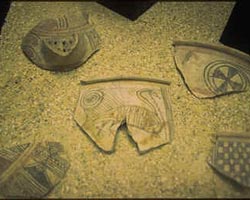
-
The Philistines are said to come from Caphtor or Crete in the Bible (Genesis 10:14, Deut. 2:23, Amos 9:7, Ezekiel 25:16, Jeremiah 47:4, Zeph.2:5, II Maccabees 5:9). Cherethites were probably Cretans. The Philistines may have also settled in western Anatolia. The Iliad in Book II (line 681) mentions the Pelasgians, allies of Troy who are probably the Philistines. At the beginning of the Iliad (Book I) there is a story of pestilence which is dealt with in a similar way as in I Samuel 5 and 6. Also there is a similar story of Megaran king Nisus who had a lock of red hair that gave him strength. His Deceitful daughter Scylla shaved his lock and betrayed him to King Minos of Crete. Goliath has been compared to Alyattes who founded the Lydian empire. The description of Goliath's armor is similar to Greek warriors in the Iliad. The Battle of David and Goliath is similar to Hector and Achilles in the Iliad (See "People of the Sea: The Search for the Philistines" by Trude and Moshe Dothan, 1992, 10; "Giving Goliath His Due" by Neal Bierling, 1992). ANET, 262. See the web site Tell es-Safi/Gath Archaeological Project.
- War with the Sea People: Confederation
of 5 groups: the Peleset or Philistines, Dardany (probably the
Danaoi of Homer's Iliad; Tribe of Dan??), Tjeker (possibly Teucri
of Troad), Shekekesh (possibly sikels of Sicily), and the Weshesh
(Carians?). The Sea people lost. The Philistines settled on the
coast of Canaan. This Battle is pictured in Ramesses III mortuary
temple at Medinet Habu, ANEP, 341. ANE 1, fig.7, 92.
-
- 18. Ramses IV-Ramses XI
-
3. Third Intermediate Period - 1069-525 BC. (Dynasties 21-26)
High Priests rule in Thebes 1080-945 BC.
-
Dynasty 21- 1069-945 BC at Tanis
Journey of Wen-Amon to Phoenicia, ANET, 25. -
Dynasty 22 - 945-712 BC at Tanis (Libyan or Bubastite)
- Sheshonq I - 945-924 BC. From a Libyan tribe who became commander-in-chief,
then King. He was a strong leader who reunited Eygpt. He is the Shishak
mentioned in the Bible. I Kings 14:25-26 says, "In the fifth
year of Rehoboam, Shishak king of Egypt attacked Jerusalem. He carried
off the treasures of the temple of the LORD and the treasures of the
royal palace. He took everything, including all the gold shields Solomon
had made" (NIV). 2 Chronicles 12:3-4 adds more details saying,
"With 1200 chariots and 60,000 horsemen and the innumerable troops
of Libyans, Sukkites (mercenary Libyan soldiers) and Cushites (Upper
Egypt) that came with him from Egypt, he captured the fortified cities
of Judah and came as far as Jerusalem" (NIV). There are
inscriptions of this on the wall of the temple of Amon in Karnak.
ANET, 263; ANEP, 349; ANE 1, fig.94.
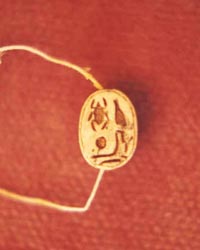
- Sheshonq I - 945-924 BC. From a Libyan tribe who became commander-in-chief,
then King. He was a strong leader who reunited Eygpt. He is the Shishak
mentioned in the Bible. I Kings 14:25-26 says, "In the fifth
year of Rehoboam, Shishak king of Egypt attacked Jerusalem. He carried
off the treasures of the temple of the LORD and the treasures of the
royal palace. He took everything, including all the gold shields Solomon
had made" (NIV). 2 Chronicles 12:3-4 adds more details saying,
"With 1200 chariots and 60,000 horsemen and the innumerable troops
of Libyans, Sukkites (mercenary Libyan soldiers) and Cushites (Upper
Egypt) that came with him from Egypt, he captured the fortified cities
of Judah and came as far as Jerusalem" (NIV). There are
inscriptions of this on the wall of the temple of Amon in Karnak.
ANET, 263; ANEP, 349; ANE 1, fig.94.
-
Dynasty 23 - 818-712 BC. (at Leontopolis)
-
Dynasty 24 - 727-715 BC. (at Sais)
-
Dynasty 25 - 747-656 BC. (Nubian/Kushite)
-
Piankhi - 747-716 BC.
-
Shabaka - 716-702 BC. "Shabaka Stone" Memphite Theology. Hoshea sent a message to So king of Egypt (II King 17:4). This is most likely not Shabaka (Gardiner 1961, 342), possibly the place name for Sais the Capitol of Egypt during the 25th Dynasty (NIV note).
-
Shebitku - 702-690 BC.
-
Taharqa - 690-664 BC Hezekiah was relying on him for help against Assyria. II Kings 19:9 "Tirhakah, king of Ethiopia (Cush, or Nubia) The story Herodotus tells about this in Book II (141) is very interesting. Both stories seem to point the bubonic plague that killed many Assyrians (NIV note, Isaish 37:36; II Chronicles 32). Herodotus writes: "One night a multitude of fieldmice swarmed over the Assyrian camp and devoured their quivers and their bows and the handles of their shields likewise, insomuch that they fled the next day unarmed and many fell (1920, 449).
-
Tanutamun - 664-656 BC.
-
Assyrians take Memphis in 671 BC. by Esarhaddon. Ashurbanipal has to retake Memphis in 669 BC uprising, and then takes Thebes. In 665 BC Tanutamun rebells and Thebes is sacked and its temple treasury taken in 663 BC. This is mentioned in Nahum 3:8. Ashurbanipal puts Nekau (Necho) as king of Sais.
-
-
Dynasty 26 - 664-525 BC.
-
Psamtik I - 664-610 BC. gains freedom from Assyria in 653 BC. Assyrian power collapses. The Babylonians under Nabopolassar advance as far as Ashdod in 627 BC. where they are stopped by the Egyptians. The capital of Assyria, Nineveh falls in 612 BC.
-
Nekau II - 610-595 BC. He is called Pharaoh Neco in the Bible in 2 Kings 23:33. Neco took Jehoahaz in chains at Riblah in the land of Hamath. Neco imposed a levy of 100 talents of gold and silver on Jerusalem. Neco made Jehoiakim king of Judah.
-
Psamtik II - 595-589 BC. (Psammetichus II) In 591 BC. He marched to southern Canaan to support Zedekiah's revolt against Babylonian rule which resulted in a two year siege of Jerusalem which finally fell in 586 BC. to Nebuchadnezzar II.
-
Wahibre - 589-570 BC. (Apries) Interveded in Canaan.
-
Ahmose II - 570-526 BC. (Amasis) He was a victorious general of the Nubian campaigns who killed Apries in 570 BC and became king. Herodotus writes about this period.
-
Psamtik III - 526-525 BC. (Psammetichus III) He was defeated by the Persian Army in 525 BC at Pelusium. He fled to Memphis where he was captured, and taken to Susa.
-
V. The Late Period - 525-332 BC. Persian Conquest
Cambyses II - 525-522 BC. Herodotus tells the stories of Cambyses II invasion of Egypt in Book 3 of Histories. A legend relates how Cambyses' army was lost in the desert on the way past Siwa Oasis.
Darius I - 521-486 BC. ANE 1, fig.196 this could be the Darius in the Book of Daniel (5:30,6:1), but it may refer to Gubaru the governor of Babylon (ANET, 306; ANE 1, 203), or Cyrus' throne name in Babylon (6:28; I Chronicles 5:26; NIV note). Darius is referred to in Ezra 4-6, Haggai 2:6-7,21-22, and Zechariah 1-8. I Esd. 4:42-5:3 says that Darius appointed Zerubbabel to restore Judah. In 490 BC Darius' army was defeated by the Greeks at Marathon.
Xerxes - 485-465 BC. ANE 1, fig.197. This is the king who chose Esther as his queen (Esther 1:1, NIV note). Susa was the winter capital of Persian kings. There were three other capitals; Babylon, Persepolis, and Ecbatana. The banquet in Esther chapter one might be the assembly mentioned by Herodotus (Book 7:8; bottom of page 443). Queen Amestris was deposed in 484 BC. The Greek historians called her Amestris, but this may be Queen Vashti in the book of Esther. She returned as Queen mother during her son's reign Artaxerxes I, and died in 424 BC.(Wright in "Historicity of the Book of Esther" in New Perspectives on the Old Testament ed. by J.Barton Payne; Word, 1970). The other possibility is that Amestris is Esther (Ishtar; see ISBE Vol.2, 1008; Herodotus Book 7:114, 9:112). Haman being an Agagite probably refers to the district of Agag in Persia. Mordecai is the Hebrew transliteration of Marduk. In a Persian text a Marduka is named as a high offical under Darius or Xerxes. This could be Mordecai agrues Carey Moore (BA 38(1975): 74). The LXX has additions to Esther.
Artaxerxes I - 465-424 BC. Artaxerxes I was born about the time his mother Amestris was deposed. He is mentioned in Ezra (7:1,7,11; 12:21), and Nehemiah (2:1, 5:14, 13:6). Nehemiah was his cupbearer. During his reign the Peloponnesian War broke out in 431 BC. where Greeks fought each other until 404 BC. This is also the Golden Age of Athens when Pericles, Socrates, Sophocles, Aeschylus, and Phidias lived.
During the 5th century BC there was a Jewish military colony at Elephantine, Egypt. Many Aramaic texts have been found here describing this period. The Jews built a temple to Yahweh with an altar for sacrifice. ANE 1, 278. ANET, 491.
Darius II - 423-405 BC.
Artaxerxes II - 405-359 BC.
-
Dynasty 28 - 404-399 BC Amyrtaeus
-
Dynasty 29 - 399-380 BC
-
Dynasty 30 - 380-343 BC
-
Dynasty 31 - 343-332 BC (2nd Persian Period)
Artaxerxes III
Darius III
Arses
VI. The Graeco-Roman Period - 332-641 BC.
-
Macedonian Kings
- Alexander the Great - 332-323 BC.

-
Philip Arrhidaeus
-
Alexander IV
- Alexander the Great - 332-323 BC.
-
Ptolemaic Dynasty 305-30 BC During this period the Ptolemy's would struggle with the Seleucid Dynasty in Syria for control of Palestine.
-
Ptolemy I - 305-282 BC.
- Ptolemy II (Philadelphus) 285-247 BC. Ordered the translation of the Hebrew Law into Greek called the Septuagint (LXX). See the Letter of Aristide (Charlesworth 1985, 7-34). The LXX was the Bible of the early church.
- Ptolemy III - 246-222 BC.
- Ptolemy IV - 222-205 BC.
- Ptolemy V - 205-180 BC. In 192 BC peace was made with Syria when
he married Cleopatra I, the daughter of Antioch the Great.
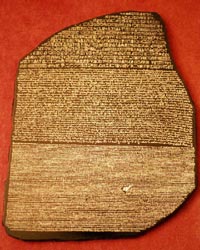
Rosetta Stone - In 1799 a French officer of engineers in Napoleon's army found a black basalt stone with writing on it at Fort Julien in Rosetta, Egypt. It had three languages on it; Egyptian Hieroglyphics, Demotic, and Greek. From this Champollion was able to decipher Egyptian Hieroglyphs. It tells the Decree of Memphis which is the decree of Ptolemy V in his 9th year in 196 BC. ANE 1, fig.72. -
Ptolemy VI - 180-164, 163-145 BC. declared war on Antioch IV who defeated Ptolemy VI in battle near Pelusium in 170 BC. Antioch IV returned in 169 BC, but Rome stopped him. In Palestine the Maccabean revolt broke out in 167 BC. See I Maccabees. Hasmonean Dynasty ruling in Palestine.
-
Ptolemy VII - 145 BC.
-
Ptolemy VIII - 170-163, 145-116 BC. ruled in Alexandria at the same time as Ptolemy VI who ruled in Memphis.
-
Ptolemy IX - 116-107, 88-80 BC.
-
Ptolemy X - 110-88 BC.
-
Ptolemy XI - 80 BC.
-
Ptolemy XII - 80-58, 55-51 BC.
-
Queen Berenice IV - 58-55 BC.
-
Queen Cleopatra VII - 51-30 BC. Cleopatra VII became Queen at age 17. She married her elder brother Ptolemy XIII who plotted to kill her. She fled to Syria, and returned with an army. After the battle of Pharalus in 48 BC. Pompey fled to Egypt from Julius Caesar. Pompey was assassinated. Julius Caesar favored Cleopatra ruling over Ptolemy XIII who then besieged the Romans on Pharos island, but was drowned in the battle. Cleopatra married her younger brother Ptolemy XIV, but had a son by Julius Caesar named Ptolemy XV Caesarion. When Julius Caesar was assassinated in 44 BC, Octavian and Anthony struggled for power which culminated in the Battle of Actium in 31 BC. Anthony broke off the fight to follow Cleopatra's ships to Egypt. The next year Octavian came with an army to Egypt (30 BC). Cleopatra committed suicide, and Anthony fell on his sword. Thus ended the last Dynasty of Egypt.
Octavian who became "Augustus" meaning "exalted" in 27 BC. took Egypt as his personal estate which was ruled by a prefect. The Republic was replaced by imperial rule. This was the Caesar under whom Jesus was born (Luke 2:1). Caesar Augustus brought an age of Peace called "Pax Romana" meaning "Roman Peace." This was the golden age of literature and architecture.
-
